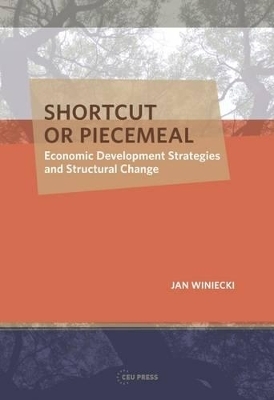
Shortcut or Piecemeal
Central European University Press (Verlag)
978-963-386-063-2 (ISBN)
Jan Winiecki is Professor and Chair of International Economics at the University of Information Technology and Management (WSIZ) in Rzeszow, Poland, former member of the Polish President's Policy Advisory Council, and author of two dozen books, the most recent being Economic Futures of the West (Edward Elgar, 2013).
List of Figures List of Tables Introduction I. DEVELOPMENTAL STRATEGIES PURSUED OVER THE PAST CENTURY Chapter 1. Centrally Planned and Administered Economy and Steep Ascent Strategy: A Complete Failure Whence Came the Economic System Considered Here? Multiple Distortions Stemming from the Soft Budget Constraint Economic Development Strategy under Central Planning The World of Make-Believe: Propaganda Image and Reality in the Economic Development of Communist Command Economies The "Shortcut" Years Lost in Chasing the Chimera Chapter 2. Development Economics-based Strategy in Less Developed Countries: An Incomplete Failure The Post-World War II International Landscape and Economic Development Whence Came the Body of Thinking Called "Development Economics" and What Kind of Recommendations It Offered? Without the Benefit of Hindsight: Some Comments on Development Economics and Pursued Strategy From Problems of Economic Growth to Growth of Economic Problems: Inward Orientation in Practice Development Economics-based Strategy: Was Inward Orientation Worth the Bother? Chapter 3. A Shift Toward Better Understood (and Appreciated) Classical Economic Prescriptions: An Incomplete Success Millsian "Conspiring Circumstances" and a Gradual Intellectual Conversion Asian "Little Dragons": Unloved Children of Developmental Success Growing Adverse Consequences of Post-WWII Ideas: The Triumph of "Conspiring Circumstances" from West to South to East Two Cheers for an Open Capitalist Market Economy: Why Is Success Incomplete So Far? II. TRANSFORMATIONS OF OUTPUT STRUCTURE IN THE PROCESS OF ECONOMIC DEVELOPMENT Chapter 4. Industrialization: The First Major Phase of Structural Transformation Introductory Remarks on the Industrialization Literature and Structural Change Patterns of Structural Change during the Industrialization Phase Amplifications and Corrections of the Standard Patterns Established in the Development Economics Literature: The Impact of Institutions Good Institutions: A Closer Look at Economic Freedom Chapter 5. The Shift to Human Capital-intensive Market Services: The Second Major Phase of Structural Transformation Between Theorizing on Structural Transformation and Alarms on Destructive Deindustrialization Determinants of Demand Shift to Market Services Commoditization of Manufactures and Changing Competitive Position of Developed Western Countries in the International Economy The Intangible Capital: Measurement, Importance, and Association with the Level of Economic Development Greater Importance of Institutional Quality in the Second Structural Transformation III. APPLYING THE CONCLUSIONS: BRIC COUNTRIES' DEVELOPMENTAL STRATEGIES Chapter 6. Russia and China: Some Historical as well as Performance Similarities (Up to a Point...) Russia's Twists, Turns, and Convulsions China's Convulsions, Failure, Turnaround, and the Glorious Present (But Not Without Question Marks about the Future) Chapter 7. India and Brazil: Two Perennial "Great Potentials" India, Its Strategies, Half Turns, and (Indeed) Great Potential Brazil: A Country Where the Future Has Arrived (Well, Not Quite...) Postscript: On Choosing Inefficient Institutions Bibliography Index
| Erscheinungsdatum | 03.02.2016 |
|---|---|
| Zusatzinfo | 12 Tables, black and white; 18 Figures |
| Verlagsort | Budapest |
| Sprache | englisch |
| Maße | 159 x 234 mm |
| Gewicht | 442 g |
| Themenwelt | Sozialwissenschaften ► Politik / Verwaltung ► Europäische / Internationale Politik |
| Wirtschaft ► Allgemeines / Lexika | |
| Wirtschaft ► Volkswirtschaftslehre ► Makroökonomie | |
| ISBN-10 | 963-386-063-6 / 9633860636 |
| ISBN-13 | 978-963-386-063-2 / 9789633860632 |
| Zustand | Neuware |
| Haben Sie eine Frage zum Produkt? |
aus dem Bereich


